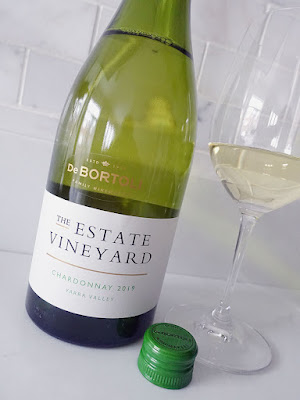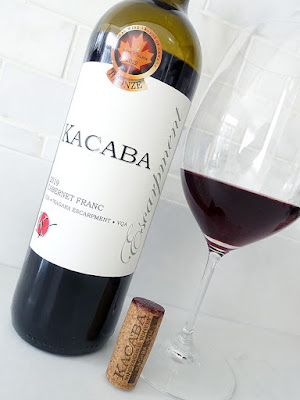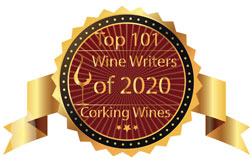white wine review is another fine Chardonnay from Australia. It is a brand-new arrival at the LCBO that landed on shelves across Ontario last month as part of the LCBO VINTAGES New Release Collection.
It is produced by De Bortoli Wines, one of Australia's leading family-owned wine companies. Their story begins when Italian immigrant Vittorio De Bortoli journeyed from Castelcucco in Treviso to New South Wales and discovered that the flat plains and red earth are very different to his homeland. His fiancée, Giuseppina, arrived in Australia a couple of years later, and in 1928 Vittorio purchased a 55 acre mixed fruit farm. In 1928, there was a glut of Shiraz grapes and many farmers saw it as cheaper to let them rot. Instead, Vittorio took them for free and crushed 15 tonnes of Shiraz grapes. The resulting wine was very popular among local Italians and other European workers in the area as they offered to buy the wine off him. Thus, the creation of De Bortoli Wines, with Vittorio and Giuseppina getting married on the farm a year later.
The 1930s brought the second generation of the family - Florrie, Deen and Eola - and also brought high demand for De Bortoli Wines as train loads of 270 litre barrels were transported to Sydney and Queensland. The family business continued to grow over the years, and in 1951, against his parents' wishes, Deen left school at the age of 15 to begin working at the family winery. By 1957, Deen was now itching to modernize the production facility. In 1958, Deen marries Emeri Cunial and the third generation of the De Bortoli family arrived in the 1960s with the births of Darren, Leanne, Kevin, and Victor.
Deen De Bortoli was instrumental in expanding the family business (normally when his dad was out of town and unaware!) during the 1970s, during Australia's first major wine boom. As a newly qualified winemaker in 1982, Deen created the highly acclaimed Noble One - a wine that has won numerous awards over the years.
In 1987, De Bortoli expanded into Yarra Valley, Victoria, where this wine is from, by purchasing an existing winery and vineyard. De Bortoli Yarra Valley Estate was established in 1990 and led by Leanne De Bortoli and her husband, Stephen (aka Steve), who is also a winemaker. Together, they welcomed the 4th generation of the De Bortoli family, and in 2007 Steve Webber was awarded Gourmet Traveller WINE magazine’s Winemaker of the Year.
Today, De Bortoli has grown to become one of Australia's largest and most respected wine producers, and is renowned for its commitment to quality winemaking, innovative practices, and sustainability. By the 2010s, De Bortoli made great strides in their sustainability initiatives and goal to become a "zero-waste" winery, while earning their first of many accolades for its achievements in sustainability that same decade. De Bortoli goes well beyond the mandatory requirements and is driven by both philosophical and pragmatic factors, but mostly by their desire to leave a legacy for future generations.
This white wine is crafted with 100% Chardonnay that was grown at the Estate Vineyard in Yarra Valley. The Estate Vineyard consists of a series of small plots of mature Chardonnay, with the oldest vines planted in 1976 and the youngest planted in 1994. These small plots are located within a few hundred metres of each other and consistently produce the finest, most detailed wines on the Estate. To craft this wine, the grapes were hand-harvested over 8 days beginning on the 19th of February, then whole-bunch pressed and allowed to settle for 4-6 hours. The juice was then racked to new and used French oak cask where it underwent natural fermentation. The lees were stirred in late Autumn, and the wine was then left to rest on its lees until November.
The growing season during 2019 was warm and early with timely rain. The conditions were very good and resulted in grapes with good, natural acidity and balanced flavours. Let's see how this 2019 Chardonnay from Yarra Valley is tasting tonight...
This vegan-friendly 100% Chardonnay is barrel-fermented and aged, and enclosed by screw cap. The fresh, medium-high intensity nose offers lovely pear, apple, and buttery aromas with accents of lemon citrus and flinty minerality. It has good weight on the dry, medium-full bodied palate with spicy flavours of pear, apple, gentle oak spice, butter, and lemon citrus. It has a crisp, textured mouthfeel with good structure and very good, juicy acidity, while leesy mineral notes linger on the crisp and lengthy finish. Will provide pleasure over the next 4-5 years and is a highly recommended buy! Score: 90 pts
Other fine wines by De Bortoli Wines can be ordered through their Agent - Dionysus Wines & Spirits.
It is produced by De Bortoli Wines, one of Australia's leading family-owned wine companies. Their story begins when Italian immigrant Vittorio De Bortoli journeyed from Castelcucco in Treviso to New South Wales and discovered that the flat plains and red earth are very different to his homeland. His fiancée, Giuseppina, arrived in Australia a couple of years later, and in 1928 Vittorio purchased a 55 acre mixed fruit farm. In 1928, there was a glut of Shiraz grapes and many farmers saw it as cheaper to let them rot. Instead, Vittorio took them for free and crushed 15 tonnes of Shiraz grapes. The resulting wine was very popular among local Italians and other European workers in the area as they offered to buy the wine off him. Thus, the creation of De Bortoli Wines, with Vittorio and Giuseppina getting married on the farm a year later.
The 1930s brought the second generation of the family - Florrie, Deen and Eola - and also brought high demand for De Bortoli Wines as train loads of 270 litre barrels were transported to Sydney and Queensland. The family business continued to grow over the years, and in 1951, against his parents' wishes, Deen left school at the age of 15 to begin working at the family winery. By 1957, Deen was now itching to modernize the production facility. In 1958, Deen marries Emeri Cunial and the third generation of the De Bortoli family arrived in the 1960s with the births of Darren, Leanne, Kevin, and Victor.
Deen De Bortoli was instrumental in expanding the family business (normally when his dad was out of town and unaware!) during the 1970s, during Australia's first major wine boom. As a newly qualified winemaker in 1982, Deen created the highly acclaimed Noble One - a wine that has won numerous awards over the years.
In 1987, De Bortoli expanded into Yarra Valley, Victoria, where this wine is from, by purchasing an existing winery and vineyard. De Bortoli Yarra Valley Estate was established in 1990 and led by Leanne De Bortoli and her husband, Stephen (aka Steve), who is also a winemaker. Together, they welcomed the 4th generation of the De Bortoli family, and in 2007 Steve Webber was awarded Gourmet Traveller WINE magazine’s Winemaker of the Year.
Today, De Bortoli has grown to become one of Australia's largest and most respected wine producers, and is renowned for its commitment to quality winemaking, innovative practices, and sustainability. By the 2010s, De Bortoli made great strides in their sustainability initiatives and goal to become a "zero-waste" winery, while earning their first of many accolades for its achievements in sustainability that same decade. De Bortoli goes well beyond the mandatory requirements and is driven by both philosophical and pragmatic factors, but mostly by their desire to leave a legacy for future generations.
This white wine is crafted with 100% Chardonnay that was grown at the Estate Vineyard in Yarra Valley. The Estate Vineyard consists of a series of small plots of mature Chardonnay, with the oldest vines planted in 1976 and the youngest planted in 1994. These small plots are located within a few hundred metres of each other and consistently produce the finest, most detailed wines on the Estate. To craft this wine, the grapes were hand-harvested over 8 days beginning on the 19th of February, then whole-bunch pressed and allowed to settle for 4-6 hours. The juice was then racked to new and used French oak cask where it underwent natural fermentation. The lees were stirred in late Autumn, and the wine was then left to rest on its lees until November.
The growing season during 2019 was warm and early with timely rain. The conditions were very good and resulted in grapes with good, natural acidity and balanced flavours. Let's see how this 2019 Chardonnay from Yarra Valley is tasting tonight...
Tasting Note:
DE BORTOLI ESTATE VINEYARD CHARDONNAY 2019 - Dixons Creek, Yarra Valley, Victoria, Australia (#33565) (XD) - $23.95This vegan-friendly 100% Chardonnay is barrel-fermented and aged, and enclosed by screw cap. The fresh, medium-high intensity nose offers lovely pear, apple, and buttery aromas with accents of lemon citrus and flinty minerality. It has good weight on the dry, medium-full bodied palate with spicy flavours of pear, apple, gentle oak spice, butter, and lemon citrus. It has a crisp, textured mouthfeel with good structure and very good, juicy acidity, while leesy mineral notes linger on the crisp and lengthy finish. Will provide pleasure over the next 4-5 years and is a highly recommended buy! Score: 90 pts
Other fine wines by De Bortoli Wines can be ordered through their Agent - Dionysus Wines & Spirits.
























